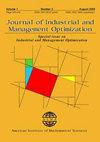Optimal trade-in rebate payment strategies for B2C platforms under different recycling models
IF 1.6
4区 工程技术
Q3 ENGINEERING, MULTIDISCIPLINARY
引用次数: 0
Abstract
Online trade-ins are becoming a booming business for B2C platforms. A B2C platform usually pays the trade-in rebate by gift card, which can be used in both self-operated and third-party stores (WP) or can only be used in self-operated stores (SR). The recycling models of B2C platforms also vary. To address the decision-making issues B2C and Internet recycling platforms, this paper considers four models: Model BWP, Model BSR(i.e., the B2C platform recycling itself and using WP or SR to pay the trade-in rebate), Model TWP and Model TSR(i.e., the B2C platform collaborating with an Internet recycling platform and using WP or SR to pay the trade-in rebate).The results imply that the B2C platform's optimal trade-in payment method depends on the utility discount rate in the SR model and the commission rate charged by the B2C platform. We also find that if the commission rate is above a given threshold, the optimal trade-in effort level in the WP model is higher than that in the SR model and the B2C platform should offer a higher subsidy in Model TWP than in Model TSR. Moreover, the proportion of the trade-in cost shared by the Internet recycling platform becomes an essential factor in the selection of the recycling model and the optimal effort level under different recycling models. We ultimately find that the recycling platform should collaborate with a B2C platform that pays the trade-in rebate by WP and offer a lower trade-in rebate if the commission rate is very high.不同回收模式下B2C平台以旧换新的最优返利支付策略
在线以旧换新正在成为B2C平台蓬勃发展的业务。B2C平台通常以礼品卡的形式支付以旧换新的返利,礼品卡可以在自营店和第三方店(WP)中使用,也可以只在自营店(SR)中使用。B2C平台的回收模式也各不相同。为了解决B2C和互联网回收平台的决策问题,本文考虑了四种模型:BWP模型、BSR模型(即BSR模型)。即B2C平台自身回收,使用WP或SR支付以旧换新返利),TWP模式和TSR模式(即(B2C平台与互联网回收平台合作,使用WP或SR支付以旧换新回扣)。结果表明,B2C平台的最优以旧换新支付方式取决于SR模型中的效用折现率和B2C平台收取的佣金率。我们还发现,当佣金率高于给定阈值时,WP模型中的最优折价努力水平高于SR模型,B2C平台在TWP模型中应提供比TSR模型更高的补贴。此外,互联网回收平台分担的以旧换新成本比例成为选择回收模式和不同回收模式下的最优努力水平的重要因素。我们最终发现,回收平台应该与B2C平台合作,B2C平台通过WP支付以旧换新回扣,如果佣金率很高,则提供较低的以旧换新回扣。
本文章由计算机程序翻译,如有差异,请以英文原文为准。
求助全文
约1分钟内获得全文
求助全文
来源期刊
CiteScore
2.50
自引率
15.40%
发文量
207
审稿时长
18 months
期刊介绍:
JIMO is an international journal devoted to publishing peer-reviewed, high quality, original papers on the non-trivial interplay between numerical optimization methods and practically significant problems in industry or management so as to achieve superior design, planning and/or operation. Its objective is to promote collaboration between optimization specialists, industrial practitioners and management scientists so that important practical industrial and management problems can be addressed by the use of appropriate, recent advanced optimization techniques.

 求助内容:
求助内容: 应助结果提醒方式:
应助结果提醒方式:


